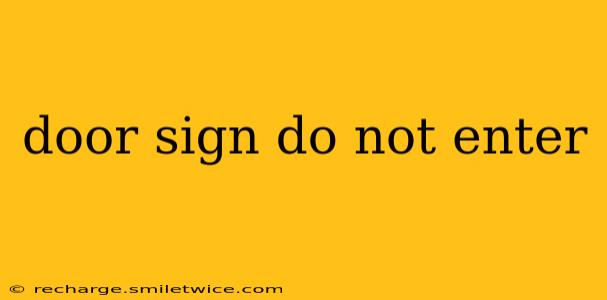A simple "Do Not Enter" sign on a door might seem straightforward, but the implications and legal considerations behind it are surprisingly complex. This guide delves into the various aspects of using "Do Not Enter" signage, covering everything from legal requirements to design considerations and alternative wording.
Why Use a "Do Not Enter" Sign?
The primary reason for using a "Do Not Enter" sign is to prevent unauthorized access to a specific area. This could be for numerous reasons, including:
- Safety: Protecting individuals from hazardous environments, machinery, or ongoing construction. A clear "Do Not Enter" sign is crucial in these situations.
- Security: Preventing theft, vandalism, or breaches of confidentiality in sensitive areas like server rooms or storage facilities.
- Privacy: Maintaining the privacy of individuals in areas like changing rooms, restrooms, or private offices.
- Regulations: Complying with health and safety regulations or legal requirements that restrict access to certain areas.
What are the Legal Implications of a "Do Not Enter" Sign?
The legal weight of a "Do Not Enter" sign varies considerably depending on jurisdiction and specific circumstances. While it doesn't automatically create a legally impenetrable barrier, it significantly strengthens a claim in the event of trespassing or an accident. A well-placed and clearly visible sign demonstrates that reasonable steps were taken to prevent unauthorized entry. However, factors such as the visibility of the sign, its clarity, and the overall context are crucial in determining its legal efficacy. Legal advice should be sought for specific situations.
What Makes a Good "Do Not Enter" Sign?
An effective "Do Not Enter" sign is more than just words on a piece of paper. Consider these elements:
- Clear Wording: Use concise and unambiguous language. "Do Not Enter," "Authorized Personnel Only," or "Keep Out" are all effective choices.
- Visibility: The sign must be easily visible from a distance and in various lighting conditions. Consider size, color, and placement.
- Placement: Position the sign where it's easily seen before someone reaches the entrance.
- Material: Choose a durable material that can withstand the elements and potential damage.
- Symbols: Combining text with universally understood symbols (like a prohibition symbol) enhances understanding.
What are the Alternatives to "Do Not Enter"?
Depending on the context, alternative wording might be more appropriate. Consider:
- "Authorized Personnel Only": This is suitable for areas requiring specific authorization.
- "Danger—Keep Out": Use this for hazardous areas.
- "No Entry": A shorter, more concise alternative.
- "Private Property—Keep Out": Clearly indicates ownership and restricted access.
What if Someone Ignores the "Do Not Enter" Sign?
Ignoring a "Do Not Enter" sign constitutes trespassing, a legal offense in most jurisdictions. The consequences can range from a warning to fines or even legal action depending on the circumstances and local laws.
How Big Should a "Do Not Enter" Sign Be?
There's no universally mandated size for a "Do Not Enter" sign. However, the sign should be large enough to be easily readable from a reasonable distance. Consider the environment; a sign in a large warehouse needs to be much larger than one on a smaller office door.
What Color Should a "Do Not Enter" Sign Be?
While there's no legal requirement for specific colors, red and white are commonly used for prohibition signs because they are easily recognizable and convey a sense of urgency and warning.
Where Can I Get a "Do Not Enter" Sign?
"Do Not Enter" signs are widely available from many sources, including office supply stores, online retailers, and signage companies. Choose a reputable supplier that offers durable and compliant signage.
This comprehensive guide provides a thorough understanding of the "Do Not Enter" sign. Remember that understanding the specific legal and safety considerations relevant to your situation is vital before choosing and placing your signage.
